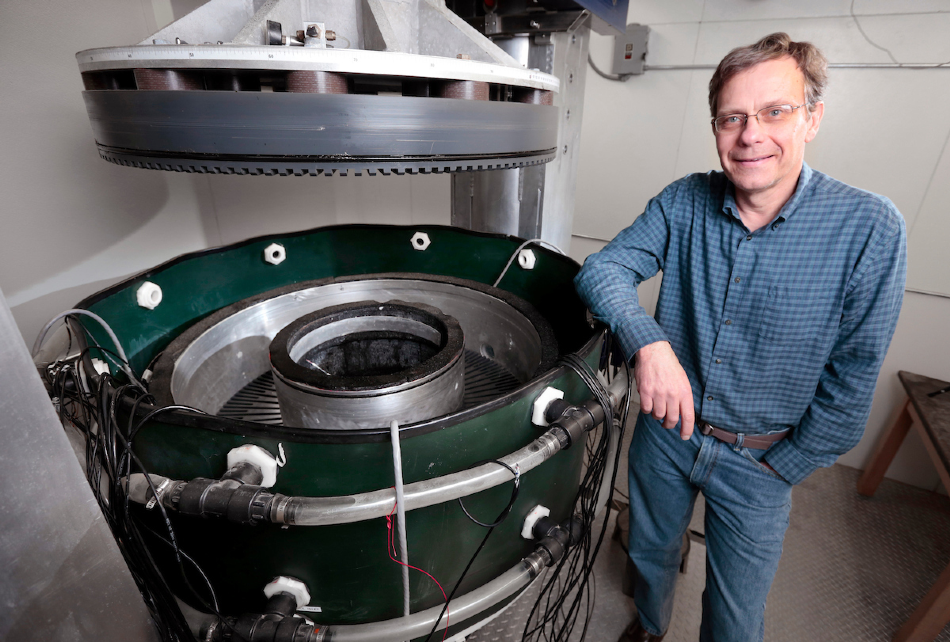Apr 3 2020
A team of glaciologists has formulated an equation that takes the motion of ice resting on soft, deformable ground beneath strangely fast-moving parts of ice sheets into account. They achieved this by using experimental data obtained from a laboratory machine mimicking the huge forces involved in glacier flow.
 Neal Iverson has worked with the ring-shear device in his laboratory freezer for more than a decade to study the huge forces involved in glacier sliding. Image Credit: Christopher Gannon.
Neal Iverson has worked with the ring-shear device in his laboratory freezer for more than a decade to study the huge forces involved in glacier sliding. Image Credit: Christopher Gannon.
According to Neal Iverson, the project leader and a professor of geological and atmospheric sciences at Iowa State University, the equation named “slip law” is a tool that can be added to computer models of glacier movement across the deformable beds of mud, rocks, pebbles, boulders, and sand under glaciers like the West Antarctic Ice Sheet.
Models using the new slip law could better estimate how fast glaciers slide, how much ice they transfer to oceans, and how that would have an impact on sea-level rise.
A new study reported recently in the online version of the Science journal explains the new slip law and the data and experiments on which it is based. The authors of the study are Lucas Zoet, a postdoctoral research associate at Iowa State from 2012 to 2015 and now an assistant professor of geoscience at the University of Wisconsin-Madison, and Iverson.
Why is a slip law essential for glaciologists?
“The potential collapse of the West Antarctic Ice Sheet is the single largest source of uncertainty in estimations of future sea-level rise, and this uncertainty results, in part, from imperfectly modeled ice-sheet processes,” Zoet and Iverson explained in the paper.
Glacier-in-a-Freezer
In 2009, Iverson started experiments using a 9-foot-tall ring-shear device within the walk-in freezer in his laboratory. A ring of ice measuring 3 feet across and 8 inches thick is located at the center of the device. A hydraulic press fitted below the ring can exert nearly 100 tons of force on the ice, simulating the weight of a glacier with a thickness of 800 feet. Motors fitted above the ring have the ability to rotate the ice at speeds of 1 to 10,000 feet per year.
A tub of temperature-controlled, circulating fluid around the ice maintains the ice ring exactly at its melting temperature such that it slides on a thin film of water—quite similar to all fast-flowing glaciers.
The device was developed with the support of a $530,000 grant from the National Science Foundation. By collaborating with three engineers from the U.S. Department of Energy’s Ames Laboratory—Terry Herrman, Dan Jones, and Jerry Musselman—Iverson converted his concepts into a working machine.
The device has operated for nearly 10 years, offering data on the ways glaciers move over deformable sediment and rigid rock.
A Drag on the Ice
To perform the experiments that resulted in the new slip law, Zoet traveled from Ames to Madison to fill real, glacially deposited sediment named till into six buckets with a volume of 5 gallons. This sediment the proper mix of sand, mud, and larger rock particles.
He scooped the sediment into the ring-shear device to form the till bed. Then, he built an ice ring over it by freezing water layers seeded with ice crystals. He applied force on the ice, heat it until it melted, and turned on the device.
We were after the mathematical relationship between the drag holding the ice back at the bottom of the glacier and how fast the glacier would slide. That included studying the effect of the difference between ice pressure on the bed and water pressure in the pores of the till—a variable called the effective pressure that controls friction.
Neal Iverson, Professor of Geological and Atmospheric Sciences, Iowa State University
The data pointed toward the relationship between “drag, slip velocity and effective pressure that is needed to model glacier flow,” stated Iverson.
Glacier ice is a highly viscous fluid that slips over a substrate—in this case a deformable till bed—and friction at the bed provides the drag that holds the ice back. In the absence of friction, the weight of the ice would cause it to accelerate catastrophically like some landslides.
Neal Iverson, Professor of Geological and Atmospheric Sciences, Iowa State University
However, it is virtually impossible to obtain drag data in the field. According to Zoet, when drilling is performed through the ice, the interface between the glacier and bed changes, rendering data and measurements less precise.
Therefore, Iverson constructed his laboratory device to gather that data, and Zoet has constructed a somewhat smaller version for his Wisconsin laboratory. The machine built by Zoet includes a transparent sample chamber that enables researchers to observe more of what happens as an experiment advances.
The ensuing experimentally based slip law for glaciers that moving over soft beds should bring about a difference in estimations of glacier movement and sea-level rise.
Ice sheet models using our new slip relationship. would tend to predict higher ice discharges to the ocean—and higher rates of sea-level rise—than slip laws currently being used in most ice sheet models.
Neal Iverson, Professor of Geological and Atmospheric Sciences, Iowa State University